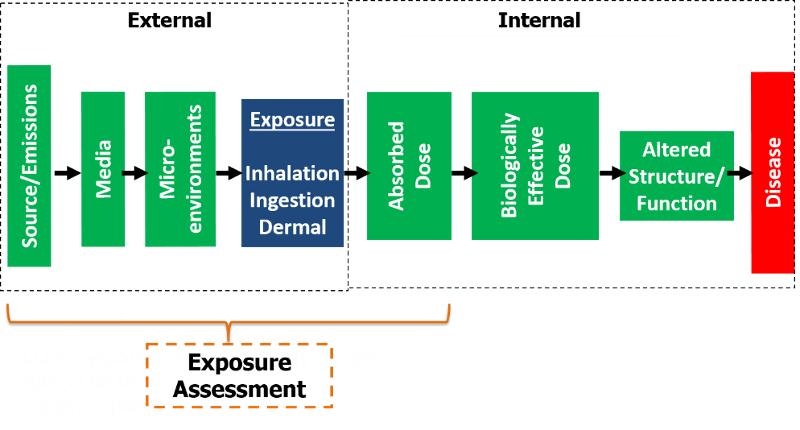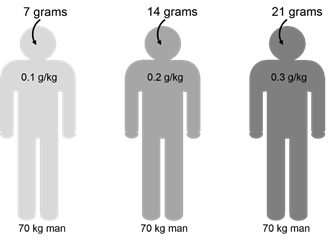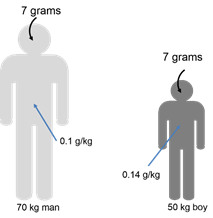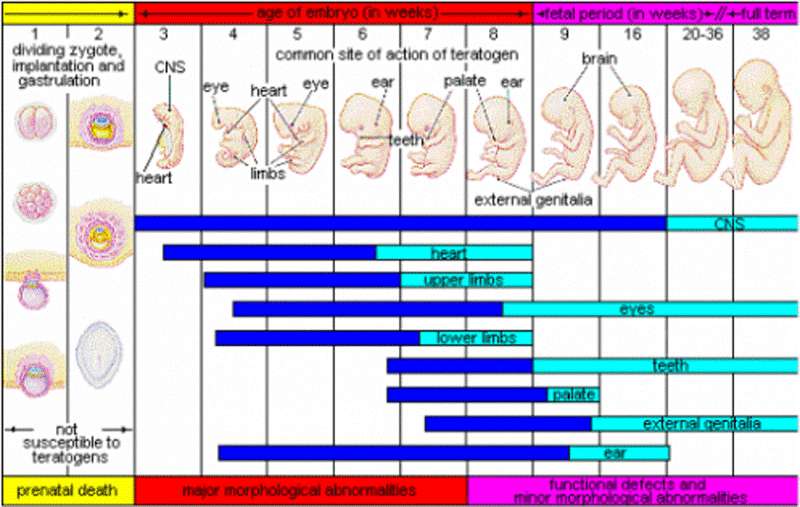Exposure Assessment
The conceptual model for understanding the link between environmental exposures and adverse health outcomes is shown below. Note that exposure assessment embraces the first five steps from identification of the source to estimation of the absorbed dose.

The goal of human exposure assessment is to identify and quantify exposures to chemical, physical, and biological agents that may have adverse health effects. This includes:
- Identification and evaluation of sources of hazardous agents
- Determination of concentrations of agents in environmental media (air, water, food, and soil)
- Identification of pathways and routes of exposure
- Determination of intensity, duration and frequency of exposure
- Determination of dose resulting from exposure
- Estimation of number of persons exposed
- Identification of high-risk groups, i.e., vulnerable persons (more likely to be exposed) and susceptible persons (those more likely to suffer adverse health effects
Armed with this information, it becomes feasible to formulate strategies to prevent or mitigate adverse health effects.
Several aspects of exposure assessment merit particular emphasis:
- Duration of exposure
- Dose and frequency of exposure
- Latency and critical window
Duration of Exposure
The duration of exposure may have an important impact on the likelihood of adverse consequences.
- Smoking one cigarette is unlikely to have long term adverse effects, but smoking a pack a day for 40 years is likely to have important adverse effects
- Eating one cookie made with trans fats is very unlikely to have long term adverse effects, but years of unhealthy eating is much more likely to have an adverse effect on health
- Visiting a nail salon once a month is unlikely to cause a health effect, but working in a nail salon six days/week for 30 years is more likely have adverse health effects
There are three categories of duration of exposures:
1. Acute Exposures
By acute exposures we mean short-term exposures to an agent (or experience) which may or may not be repeated
Examples:
- A child ingesting pesticide from your garage
- Spilling acid on your hand
- Eating undercooked chicken that is contaminated with Salmonella
- Smoke inhalation during a fire at one's place of work
2. Chronic Exposures
These are exposures that are present for long periods of time; possibly constant; possibly life-long.
Examples:
- Outdoor air pollution
- Occupational exposures: e.g., painters exposures to solvents
- Exposure to contaminants in drinking water (e.g., arsenic)
- Radon in one's basement
- Neighborhood poverty
- Racism
3. Time-varying Exposures
Time-varying exposures are those that vary across the life course of an individual, such as beginning to smoke and gradually increasing the amount, then quitting. Other time-varying exposures might include:
Examples:
- Diet and exercise
- Alcohol consumption
- Marital status
- Some occupational exposures
- Stress
Dose and Frequency of Exposure
Estimating the overall dose of exposure is complicated, since it can be influenced by:
- quantity
- intensity (or concentration)
- frequency of exposure and
- the route of exposure (inhalation, ingestion, or dermal absorption)
For example, rough estimates might be calculated as follows:
- Oral dose = amount of substance consumed (mg)/body weight (kg) x days
- inhalation dose = Air concentration of agent (mg/ml) x volume of air inhaled per hour (ml/hr.) x duration of exposure (hr.)/body weight (kg) x days
Body size also matters. At a given body weight, the internalized concentration will increase as the amount of contaminant ingested increases.

Conversely, if the same amount of a contaminant is ingested by two people of different body weights, the smaller person will have a higher concentration of the contaminant.

Induction, Latency, and Critical Windows
- Induction: Is the length of time between exposure and disease initiation.
- Latency: Is the length of time between disease initiation and the appearance of the clinical manifestations.

- Critical window: Some exposures might have harmful effects if they occur during a particular time along the life span.
In the 1950s and 1960s pregnant women with tenuous pregnancies were often prescribed a drug called diethylstilbestrol (DES). Years later it was found that the in utero exposure to DES caused cancer of the vagina in exposed offspring 15 to 22 years later. This is an example of both critical window (exposure in utero) and long latency.
A more recent example of a critical window is infection of pregnant women with Zika virus, causing microcephaly (smaller than normal head and underdeveloped brain) in their babies.
The illustration below shows a time line of fetal development of each of the major organ systems during pregnancy. Blue bars show critical windows for development of major congenital defects in each organ system, and turquoise bars show critical windows for minor congenital defects.

Source: US Environmental Protection Agency (EPA)
https://www.epa.gov/sites/production/files/2014-04/childrens_health_1.gif


